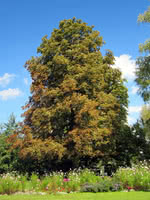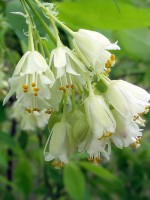Mon-Fri 9am - 5pm Mountain time
Horse Chestnut vs American Bladdernut
Aesculus hippocastanum
Staphylea trifolia
CUSTOM GROW
NOT AVAILABLE THIS SEASON - MIGHT RETURN
Horse Chestnut is a medium sized deciduous tree that is native to Greece but has been grown in North America for hundreds of years. It produces large nuts.
A top CO2 absorbing species. Experts think this tree may help climate change more than others.
American Bladdernut is a fast-growing, ornamental shrub native to eastern North America. It can be grown as a large shrub or trained as a small tree. The small, drooping, white flowers are bell-shaped and grow in clusters. They appear in mid to late spring, attracting various pollinators. Well suited as an understory plant as it prefers shady and partial sun location with moist soils.
The blossoms mature into papery seed capsules and have been described as miniature Japanese lanterns. They are commonly used in dried flower arrangements. The seeds found within the pods are edible, and have a taste similar to pistachios. They can be eaten raw, used in baking or made into a sweet cooking oil.
Care should be taken when planting American Bladdernut, as it can spread quickly. It is prone to suckering and will self-seed. Plant the right tree in the right place.
Horse Chestnut Quick Facts
American Bladdernut Quick Facts
Toxicity: most parts of plant are toxic

